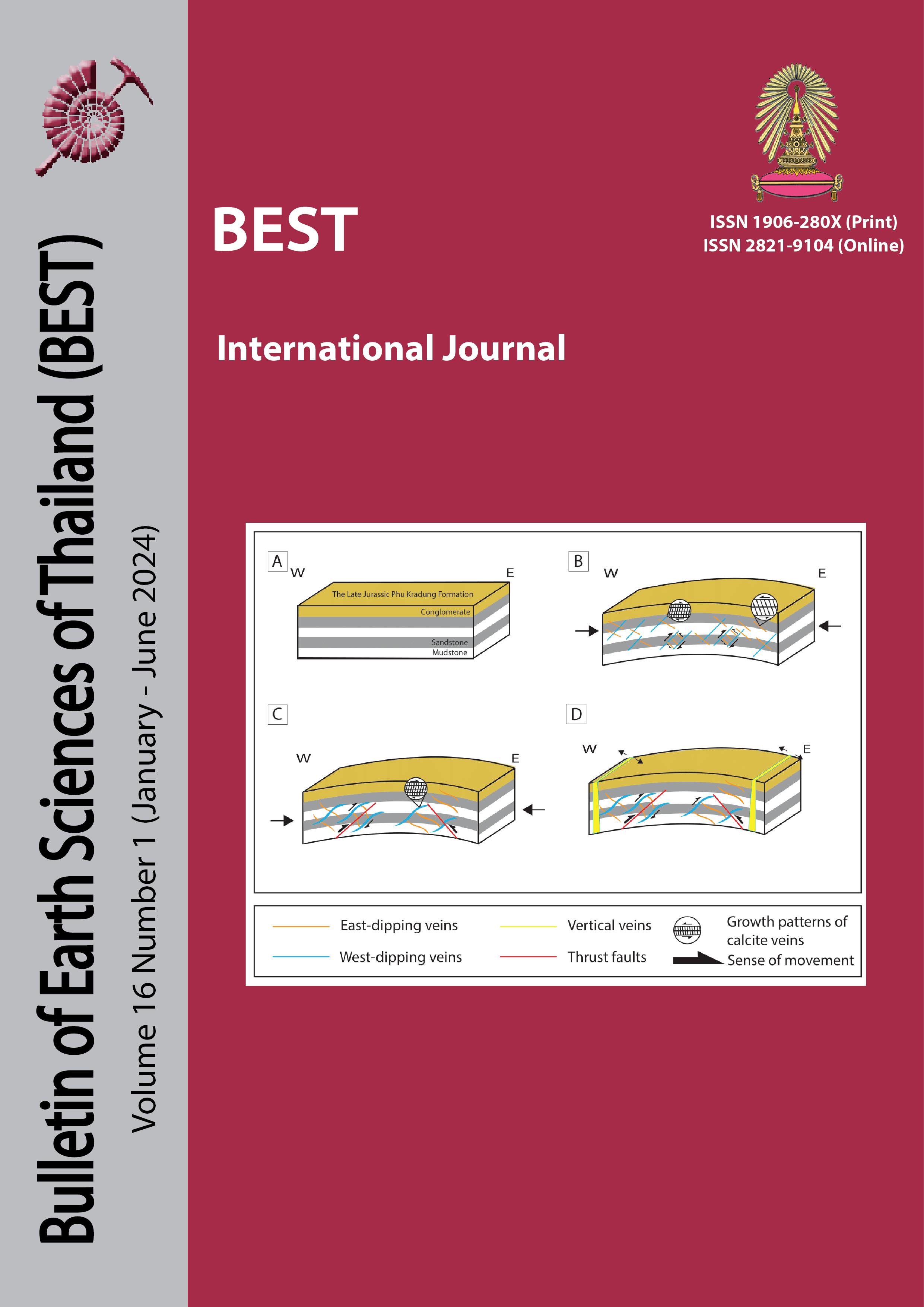Preliminary geotourism study of laterite attraction in Kamphaeng Phet Province, northern Thailand
Main Article Content
Abstract
A UNESCO World Heritage Site in Kamphaeng Phet, which once was a part of the Sukhothai Kingdom, showcases stunning architecture constructed from laterite with rich cultural traditions, making it a popular tourist destination (e.g., temples, pagodas, ponds, and walls). These attractions are surrounded by several laterite quarries, which are believed to have been used in the construction of those places. They carry significant scientific and historical importance, positioning them as potential geoarchaeological tourism destinations. This research primarily focuses on the geological features in the vicinity of these laterite attractions. Seven specific laterite attractions were selected in Kamphaeng Phet, including (1) Kamphaeng Phet Historical Park within the city walls, (2) Kamphaeng Phet Historical Park in the Aranyika region, (3) Nakhon Chum Historical Site, (4) Wat Nong Pling, (5) Blue Pond Kamphaeng Phet, (6) Tham Nang Thong archaeological site, and (7) Wat Khanathi Si Wachiraram. Guidelines for geotourism development were thoroughly analyzed for these sites. Additionally, the study conducted evaluations of the attractions, singling out Kamphaeng Phet Historical Park and Nakhon Chum Historical Site as possessing higher geoheritage values. Furthermore, a SWOT analysis was performed to establish management priorities. Finally, a tourist route map connecting between laterite attractions and laterite sites in Kamphaeng Phet was generated, providing valuable information and knowledge about the history and geology of laterite in the province. This research contributes to the increased geosite potential in the area of the national historical park, potentially paving the way for it to become a geopark.
Article Details

This work is licensed under a Creative Commons Attribution-NonCommercial-NoDerivatives 4.0 International License.
Copyright © 2008 Department of Geology, Faculty of Science, Chulalongkorn University. Parts of an article can be photocopied or reproduced without prior written permission from the author(s), but due acknowledgments should be stated or cited accordingly.
References
Brocx, M., & Semeniuk, V. (2007). Geoheritage and geoconservation - History, definition, scope and scale. Journal of the Royal Society of Western Australia, 90, 53-87.
Department of Mineral and Resources. (2012). Classification of Zones for the Management of Geology and Mineral Resources in Kamphaeng Phet Province. DISC SUPPLIES INTERNATIONAL CO., LTD.
Dowling, R. K. (2011). Geotourism’s Global Growth. Geoheritage, 3(1), 1-13. https://doi.org/10.1007/s12371-010-0024-7
Đurović, P., & Đurović, M. (2010). Inventory of Geoheritage Sites – the Base of Geotourism Development in Montenegro. Geographica Pannonica, 14, 126-132. https://doi.org/10.5937/GeoPan1004126D
Fine Arts Department. (2021). Kamphaeng Phet Historical Park. Retrieved 2.12.22 from http://virtualhistoricalpark.finearts.go.th/kamphaengphet/index.php/th/
Fine Arts Department. (2023). Kamphaeng Phet Historical Park. Retrieved 12.9.23 from https://www.finearts.go.th/kamphaengphethistoricalpark/categorie/about
Gray, M. (2004). Geodiversity: Valuing and Conserving Abiotic Nature.
Gray, M. (2005). Geodiversity and Geoconservation: What, Why, and How? The George Wright Forum, 22(3), 4-12. http://www.jstor.org/stable/43597951
Kamphaeng Phet Provincial Office of Buddhism. (2023). Kamphaeng Phet Provincial Dhamma Practice Center 2nd Place: Wat Nong Pling. Retrieved 12.9.23 from https://kpt.onab.go.th/th/content/category/detail/id/20/iid/6587
Ministry of Natural Resources and Environment. (2023). Phae Mueang Phi Forest Park. https://naturalsite.onep.go.th/site/detail/195
Nazaruddin, D. A. (2020). Granite landforms of Samui Island (southern Thailand) from geoheritage, geoconservation and geotourism perspectives. International Journal of Geoheritage and Parks, 8(2). https://doi.org/https://doi.org/10.1016/j.ijgeop.2020.05.003
Newsome, D., & Dowling, R. (2018). Chapter 17 - Geoheritage and Geotourism. In E. Reynard & J. Brilha (Eds.), Geoheritage (pp. 305-321). Elsevier. https://doi.org/https://doi.org/10.1016/B978-0-12-809531-7.00017-4
Newsome, D., Dowling, R., & Leung, Y.-F. (2012). The nature and management of geotourism: A case study of two established iconic geotourism destinations. Tourism Management Perspectives, 2-3, 19-27. https://doi.org/https://doi.org/10.1016/j.tmp.2011.12.009
Newsome, D., Ladd, P., & Dowling, R. (2021). The Scope for Geotourism Based on Regolith in Southwestern Australia—a Theoretical and Practical Perspective. Geoheritage, 14(1), 5. https://doi.org/10.1007/s12371-021-00632-1
Ólafsdóttir, R., & Tverijonaite, E. (2018). Geotourism: A Systematic Literature Review. Geosciences, 8(7), 234. https://www.mdpi.com/2076-3263/8/7/234
Paungya, N., Singtuen, V., & Won-In, K. (2020). THE PRELIMINARY GEOTOURISM STUDY IN PHETCAHBUN PROVINCE, THAILAND. Geo Journal of Tourism and Geosites, 31, 1057-1067. https://doi.org/10.30892/gtg.31318-541
Ruban, D. A. (2015). Geotourism — A geographical review of the literature. Tourism Management Perspectives, 15. https://doi.org/https://doi.org/10.1016/j.tmp.2015.03.005
Sharples, C. (2002). Concepts and principles of geoconservation.
Singtuen, V., & Phajuy, B. (2020). Archaeological Distribution of Geoheritage for Geotourism Development in Nakhon Sawan Province, Thailand. Quaestiones Geographicae, 39, 57-68. https://doi.org/10.2478/quageo-2020-0023
Treasury Department. (2019). About the province, Kamphaeng Phet Area, Treasury Office. Retrieved 2.12.22 from https://kamphaengphet.treasury.go.th/th/about/


